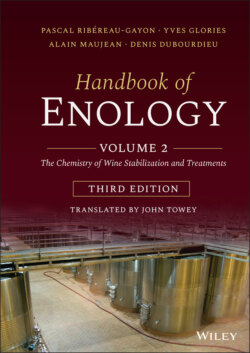Читать книгу Handbook of Enology, Volume 2 - Pascal Ribéreau-Gayon - Страница 30
1.5.3 Using Electrical Conductivity to Monitor Tartrate Precipitation
ОглавлениеWurdig and Muller (1980) were the first to make use of the capacity of must and wine to act as electrolytes, i.e. solutions conducting electricity, to monitor tartrate precipitation. Indeed, during precipitation, potassium bitartrate passes from the dissolved, ionized state, when it is an electrical conductor, to a crystalline state, when it precipitates and is no longer involved in electrical conductivity:
The principle of measuring conductivity consists in making the wine into an electrical conductor, defined geometrically by the distance l separating two platinum electrodes with S‐shaped cross sections. The resistance R (in ohms) of the conductor is defined by the relation:
TABLE 1.12 Resistivity and Conductivity of a KCl (0.02 M) Solution According to Temperature (in °C).
| Temperature (°C) | 15 | 16 | 17 | 18 | 19 | 20 | 21 | 22 | 23 | 24 | 25 |
| Resistivity (Ω/cm) | 446 | 436 | 426 | 417 | 408 | 400 | 392 | 384 | 376 | 369 | 362 |
| Conductivity (μS/cm) | 2,242 | 2,293 | 2,347 | 2,398 | 2,451 | 2,500 | 2,551 | 2,604 | 2,659 | 2,710 | 2,769 |
In this equation, ρ is the resistivity. Its inverse (γ) is the conductivity expressed in siemens per meter (S/m) or microsiemens per centimeter (μS/cm = 10−4 S/m).
The expression of resistivity ρ = RS/l involves the term S/l, known as the cell k constant. This constant is specific to each cell, according to its geometry, and may also vary with use, due to gradual deterioration of the electrodes or the effect of small impacts.
It is therefore necessary to check this constant regularly and to determine it at a conductivity close to that of wine. In practice, a 0.02 M KCl solution is used. The temperature of the KCl (0.02 M) solution must be taken into account when checking the cell constant. The resistivity and conductivity values of this solution according to temperature are specified in Table 1.12.
The conductivity meter cell is subjected to an alternating current. The frequency is set at 1 kHz for the standardized solution (KCl = 0.02 M) and for wine to avoid polarizing the electrodes. A conductivity meter is used for continuous monitoring of tartrate precipitation in wine (see Section 1.6.4, Figure 1.16).
